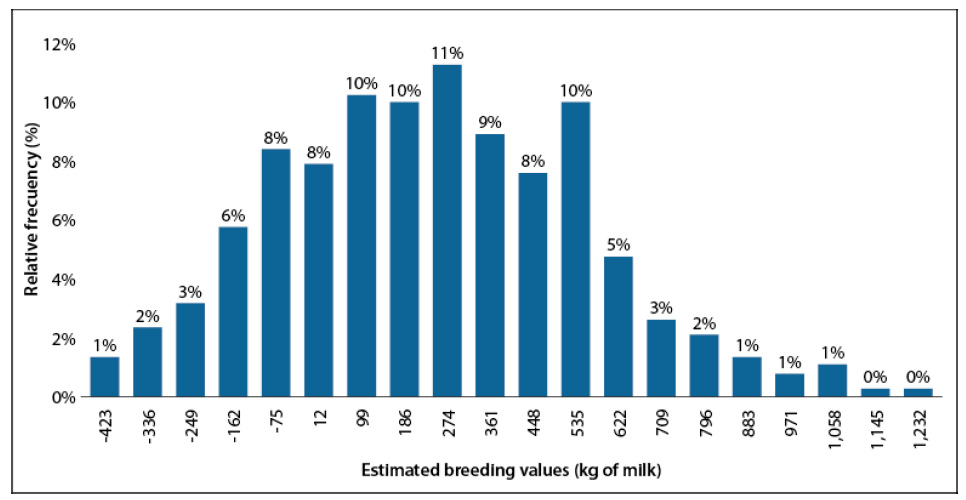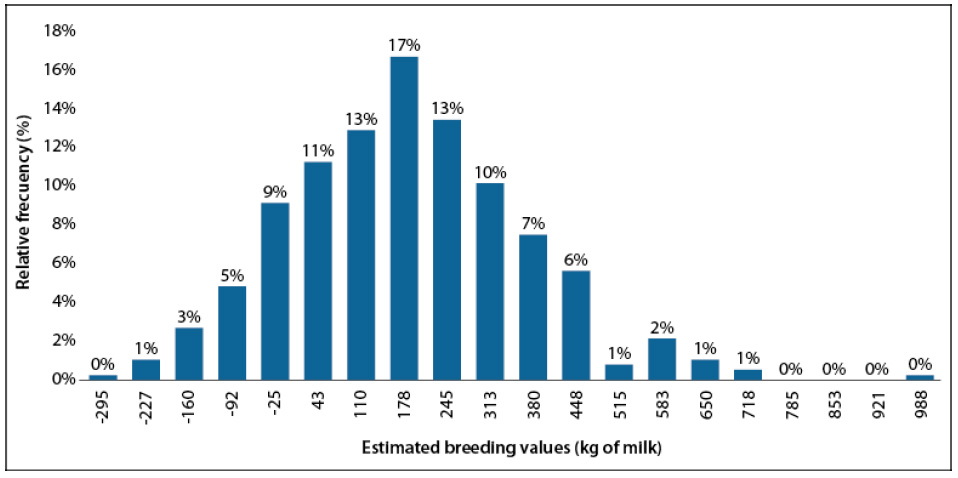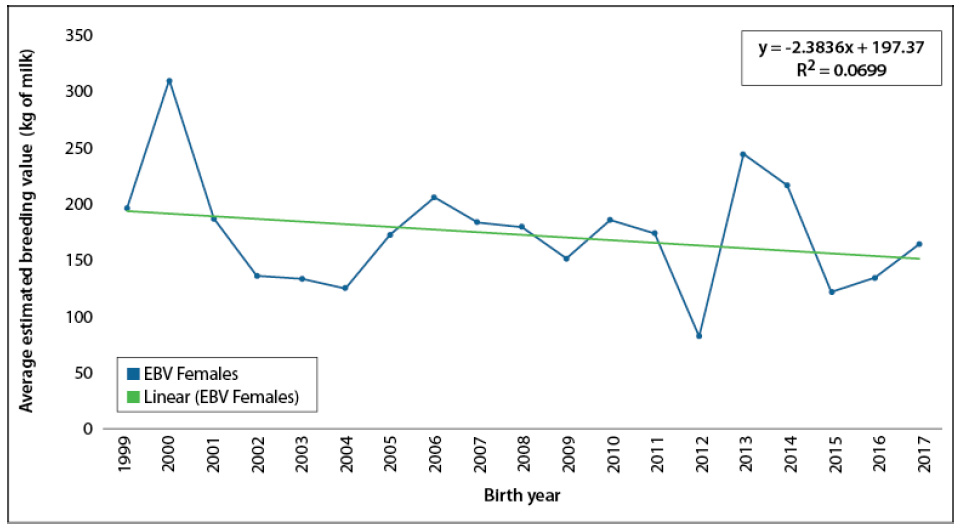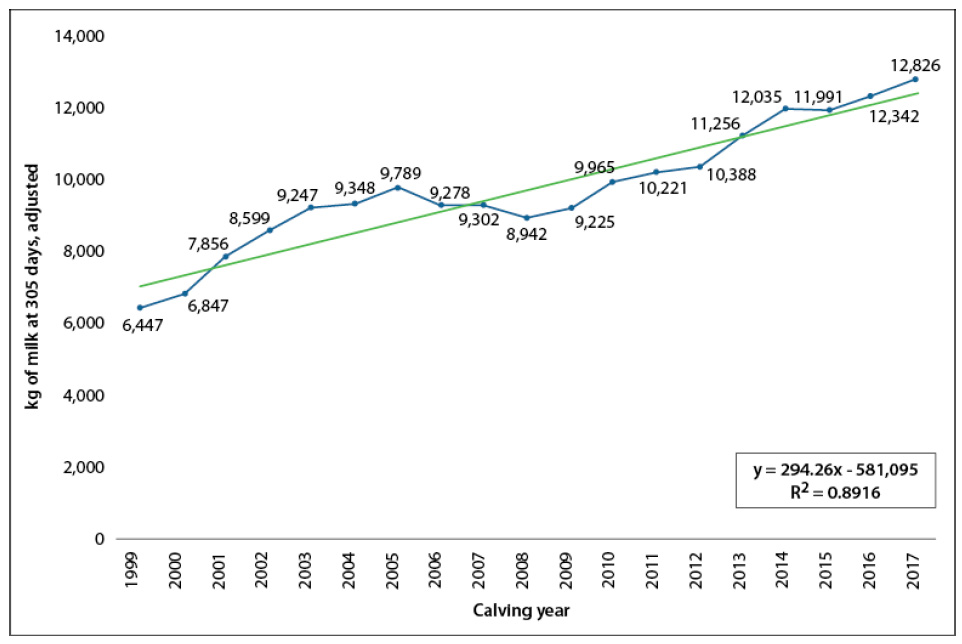Introduction
In 2017, more than 2 tons of cow milk were produced in Peru, representing an increase of 3 % compared to 2016 (Sistema Integrado de Estadística Agraria [SIEA], 2017). This increase in the levels of national milk production is due to the higher production obtained in the different departments. Environmental and genetic factors influence milk production, and the latter are the only ones that can be transmitted from parents to offspring (Amorim, 2006). Thus, the genetic value is the most recommended estimate for the selection of animals as future reproducers. Missanjo et al. (2012) pointed out that the behavior of the mean values per year defines a genetic tendency that will help to establish the future genetic direction of the herd; therefore, it is crucial to perform an analysis of the phenotypic and genetic tendencies of the desired trait to know the behavior of genetic and phenotypic values over time.
In Peru, genetic evaluations of Holstein cattle populations were implemented in 2016; according to Gutiérrez et al. (2016), these evaluations would be made every six months in order for this information to be used by farmers to improve livestock. However, to date, there is no information about new evaluations, so work must be carried out to know the genetic value of animals included in the herds. This would be beneficial for Peru, since the herds could make a better selection of their reproducers and provide males to the National Semen Bank. This research aimed to establish the genetic and phenotypic trends for milk production of Holstein cows during the 1999 to 2017 period in a herd in the Huaura Valley, from the genetic values estimated using a repeated-measures animal model.
Materials and methods
Records of the Holstein cows belonging to the Granados herd located in the Huaura Valley, in the Lima Province region (Peru) were used. The region is located above 30 m a.s.l., with an average annual temperature of 19.1 °C and a desert-type climate. Summers are hot and sultry, with temperatures between 18 °C and 28 °C and a humidity of 88 %. In 2017, according to the Official Service of Milk Productivity [Servicio Oficial de Productividad Lechera] (SOPL), this herd had 532 cows in total, of which 86 % are under milking (i.e., 460 cows), with an overall average daily production of 30.1 kg/day and an average production of 34.8 kg/day for cows under milking, performing a total of three milkings per day. The breeding system is of a complete intensive type, with a diet based on an integral ration (RTM), using corn and corn silage as a forage source. Regarding reproductive management, artificial insemination is currently performed using imported semen from different commercial houses.
The records used contained the productive information provided twice a month by the SOPL of the Lima Basin, of the Animal Breeding Programme of Universidad Nacional Agraria La Molina, Peru. Information on each cow was collected, including the earring number, birth date, pedigree of the sire, and earring of the dam, calving number, calving date, standardized milk production at 305 days, and two milkings. From the database of the Council on Dairy Cattle Breeding (CDCB) and the genealogical registration certificates of the Holstein Association of Peru, the full name and genealogical record of the Holstein breed and country of origin of the imported bulls were collected, as well as their ancestors (sire and dam) and birth date. For the estimation of the genetic values, an animal model with repeated measures was used (Henderson, 1988), whose matrix model is represented in equation 1.
Where Y is the milk production observations vector at 305 days of different calvings; β is the fixed effects vector with incidence on matrix X, containing the effect of the calving year-season with 75 different levels (four seasons per year from 1999 to 2017), the effect of the calving number with five levels (first to fifth calving), and the effect of the calving age as a linear and quadratic covariate; u = ~N (0, σ2uA) is the additive genetic random effects vector of all the animals in the population (males and females) with an incidence in the Z matrix, and contains 3,404 levels; pe = ~N (0, Ic σ2pe) is the permanent environment effect vector (of the cows with a milk production record) with incidence on the W matrix, and contains 1.892 levels; e = N (0, In σ2e) is the random residual effects vector; X, Z, and W are the design or incidence matrices that relate the fixed, random and permanent environment effects with the data, respectively.
The expectations and variances of the model are presented in equation 2.
Where σ2u is the additive genetic variance; σ2pe is the permanent environment variance; σ2e is the residual variance; A is the kinship relationship matrix; Icand Inare the identity matrices of order equal to the number of cattle heads and number of data, respectively.
The genealogy consisted of a total of 3,404 individuals, including 2,969 females and 435 males born during the 1948-2017 period. This sample contained all the animals present in the database, with or without records (ancestors, cows, bulls, and progeny). Of all the females, 2,590 were daughters born in the herd, and only 1,892 had milk production records (2,862 standardized lactations at 305 days and two milkings).
Equation 3 shows the mixed model for the repeated-measures animal model as a matrix.
The best linear unbiased predictors (BLUP) for random effects and the best linear unbiased estimators (BLUE) for fixed effects are obtained by solving this system of equations (Gutiérrez, 2010). For the estimation of the variance components and genetic values, the ASReml software was used. Gilmour et al. (2015) indicated that ASReml is a statistical software that adjusts to linear mixed models using the restricted maximum likelihood (REML) approach. The trends were established through a regression analysis performed in the statistical package SAS (Statistical Analysis Systems) version 9.4, using the PROC REG procedure. Graph trends were obtained using Microsoft Excel 2013. The average EBV values per birth year were used to determine the genetic trend. The phenotypic trend was estimated employing the mean milk production records adjusted to 305 days for the calving year.
Results and discussion
Genetic assessment of milk production
The variance components estimated with the ASReml software for milk production per lactation at 305 days of the Holstein cattle from the Granados herd is shown in table 1.
Table 1 Variance components (expressed as a proportion of the phenotypic variance) for milk production per lactation at 305 days of the Holstein cattle in the Granados herd, Peru

Source: Elaborated by the authors
Heritability (h2) estimated for MP in the Granados herd was 0.16 with a standard error (S.E.) of 0.03, which means that 16 % of the variation in milk production is due to the additive genetic variation and the rest (84 %), to the genetic variation of dominance, epistatic, and environmental variance. Falconer and Mackay (1996) reported that h2 expresses the degree to which phenotypes are determined by genes passed down from their parents. This value is lower than that reported by Arango and Echeverri (2014), Galeano and Manrique (2010), and Palacios et al. (2001), who obtained for the same characteristic, h2 values of 0.19 (0.00), 0.35 (0.06), and 0.26 (0.09), respectively. González et al. (2009) estimated an h2 of 0.14 (0.02) using ASReml, and indicated that higher values are obtained using the derivative-free restricted maximum likelihood (DFREML) and Bayesian methods. However, the h2 obtained in the current study is similar to the one reported by Corrales et al. (2011) and Hernández et al. (2011) with values of 0.17 (0.00) and 0.15 (0.01), using DFREML and ASReml, respectively.
The estimated repeatability (r) was 0.28 (S.E. 0.025), indicating that 28 % of the variation in MP is due to the effect of genetics and the permanent environment, and 72 %, to the temporary environment. This value was lower compared to the one obtained by Galeano and Manrique (2010) and Hernández et al. (2011), who reported values higher than 0.40. The low values of these parameters may be due to the scarce productive information recorded per animal and the lack of adjustment before applying the model. However, it should be considered that both heritability and repeatability are not universal parameters; that is, they depend on the population, since both the variance of additive and non-additive genetic effects and the variance of the environment are specific to each population (Quijano & Echeverri, 2015).
Estimated breeding values of females
Of the 2,590 evaluated females from the Granados herd, only 755 are currently kept alive; of these, 381 (50.5 %) are cows with more than one lactation, and 374 (49.5 %) are young animals. The estimated breeding values (EBV) for live cows had an average of +200.9 (S.E. 16.1 kg), with a minimum value of -510.6 and a maximum value of +1,190; furthermore, 72 % of the animals had positive values. The average accuracy for the EBV was 33 %, varying from 10 % to 51 %, due to the variation in the amount of milk production and genealogical data per cow (Vargas & Gamboa, 2008). An alternative that allows improving the accuracy of the genetic evaluation is to use Test-Day models, since individual data are utilized per day and not for total lactation (Kaygisiz, 2013). The relative frequency of live cows according to their EBV, where 25 % had values for milk production lower than or equal to -27.02, 50 % had values lower than or equal to +197.4, and 75 % had values lower than or equal to +426.4 as shown in figure 1.

Source: Elaborated by the authors
Figure 1 Relative frequency of live cows according to their estimated breeding values
The EBV for live calves had an average of +148.7 (S.E. 9.7 kg) with a minimum value of -362.5 and a maximum of +943.4. Of the 374 young females, 78 % of the animals had positive values. The relative frequency of live calves according to the EBV, where 25 % of them had values for milk production lower than or equal to +22.04, 50 % had lower than or equal to +139.5, and 75 % have lower than or equal to +263.9 as shown in figure 2. A higher percentage of animals with positive genetic values were observed in recent years, indicating the presence of young females that are available to be selected.

Source: Elaborated by the authors
Figure 2 Relative frequency of live calves according to their estimated breeding values
The EBV of the Granados herd cows decreased from an average of +197 kg of milk in 1999 to +164 kg in 2017, with an average change of -33 kg in this 18-year-period. The EBV for MP of cows has shown an annual decrease estimated by regression of -2.4 kg/year (S.E. 2.1) in the 1999-2017 period (figure 3), being a negative value, which does not contribute to a high increase for MP, because the selection of bulls was based on type and MP traits.
Genetic trends superior to those estimated in this study for Holstein cows were reported by the CDCB in the USA, with a positive trend for MP of 75 pounds/year (+34.3 kg/year). Other authors, such as Vargas and Gamboa (2008) in Costa Rica, recorded an increase of 6.7 kg/year in a 22-year-period for Holstein cattle. Toledo et al. (2014) in Mexico, estimated an increase of +30 kg of milk per year; Haiduck et al. (2019) in Brazil, found a trend of +17.5 kg/year, and Chegini et al. (2013) in Iran, obtained +21 kg of milk per year. These results may be due to the use of bulls of higher genetic value for this trait, selected based on the environment in which production occurs in these countries. In the Granados herd, the selection was made considering other traits, such as conformation and type, in addition to milk production, which can generate a low tendency for this trait. Hossein-Zadeh (2011) conducted an investigation in Iran during the years 1990 to 2007 and obtained a genetic trend of + 4.2 kg of milk per year, attributing the low values to the low use-frequency of proven bulls and positive for milk production.

Source: Elaborated by the authors
Figure 3 Genetic trend in milk production at 305 days for Holstein cows from the Granados herd, Peru (1999-2017)
In Turkey, Katok and Yanar (2012) and Sahin et al. (2012) evaluated Holstein cattle, finding a genetic trend of +3.7 kg/year and -2.46 kg/year, respectively. These low values are due to the selection of bulls based on pedigree records and phenotypic observations rather than on more reliable breeding value estimates such as performing tests; meanwhile, in the Granados herd, the selection of bulls is done by phenotype and considering the genetic evaluations from other countries. Therefore, the genetic change was low because evaluations carried out in different conditions to the ones of the herd were considered, as the improvement objective was not only milk production and, probably, the limited amount of data and the statistical model used in this research.
Throughout the study period, the EBV varied, increasing or decreasing. According to Araújo et al. (2003), one explanation for variations in the genetic trend is the disorganized flow of genetic breeding; that is, each producer adopts its own selection objectives independent of the others. This would explain the fluctuation of the EBV, since the selection objective varied through the years in the Granados herd.
From 1997 in the Granados herd, there were administrative changes and, with this, the new manager began to select bulls in search of higher MP; therefore, a growing trend is observed between 1999 and 2000. From this year onwards, there were changes concerning the selection objective, focusing not only on milk production, but also on type and conformation traits. These selection objectives continue to be maintained in the Granados herd, seeking to balance milk production improvement and having animals that are kept longer in the herd. Therefore, the EBV behavior will depend on the decisions that each producer has at the moment of selecting their animals. Hence, the importance of the interpretation of the analysis that estimate the breeding trends, since it allows ensuring that the selection is directed towards economically important traits, and defining the selection objectives.
The mean observed values and the linear estimate of the phenotypic trend are shown in figure 4; moreover, during the 1999-2017 period, the Granados herd doubled its milk production at 305 days, going from 6,447 kg to 12,826 kg; that is, it showed an increase of 6,379 kg of milk during that period. The estimated phenotypic trend of the Granados herd for MP was +294.3 kg (S.E. 24.9 kg) of milk per year in a campaign adjusted to 305 days. The regression equation was -581.09 + 294.3X, with an R² = 0.89.

Source: Elaborated by the authors
Figure 4 Phenotypic trend in milk production at 305 days for Holstein cows in the Granados herd, Peru (1999-2017)
For the phenotypic trend, some authors attribute that it is the result of genetic breeding and, to a lesser extent, to environmental factors. For example, García et al. (2016) indicated that more than 56 % of the increase in milk production in the United States could be attributed to a genetic change. In India, Dash et al. (2016) obtained a trend of +18.71 kg of milk for Holstein cows in a 34-year-period (1972-2012). In Thailand, Konkruea et al. (2017) estimated a trend of +21.3 kg/year for the 1991-2014 period. These investigations suggest that yield improvement results from the selection policy of breeders, emphasizing exclusively on the production trait.
Other researchers, on the contrary, found that increases in production yields are the result of improvements in environmental factors. Authors such as Vargas and Gamboa (2008) have estimated a positive phenotypic trend of +97.1 kg of milk at 305 days for Holstein cows in Costa Rica during the 1985-2007 period, attributing that these increases were due, mostly, to environmental factors and, to a lesser extent, to genetic factors.
Sahin et al. (2012) estimated a linear phenotypic trend of +122 kg/year and concluded that this increase in phenotypic values for milk production seems to be due to improved environmental conditions. On the other hand, in Turkey, Katok and Yanar (2012) estimated a phenotypic trend of -17.7 kg/year, and indicate that the decrease in this phenotypic trait could be attributed to adverse environmental factors, the presence of diseases, and insufficient feeding. Harsh climatic and geographic conditions could be some of the environmental reasons responsible for this negative value.
The phenotypic trend estimated for this work is higher than those mentioned above. The variation in these trends reflects the management level, which varies according to the skill of the herd manager, his/her efficiency in supervising activities, and forage management (Katok & Yanar, 2012; M’hamdi et al., 2012).
The increase in the average milk production in the years studied in the Granados herd is mainly due to improvements in environmental conditions, and to a small extent, the selection or introduction of superior genes. The main improvements established can be indicated. In 2000, there was an average of 6,847 kg of milk; in this same year, the forage presentation provided to cows was changed, going from a supply of whole corn husk to one with chopped corn; the animals are re-categorized according to their level of production. Different diets were established for each category, thus, obtaining for 2002, an average of 8,599 kg of milk per lactation at 305 days. From 2002, the number of portions per day was increased, from one to two; more land was acquired, and facilities were improved. The animals were also separated according to calving number, and mechanical milking was established, since the milking was previously carried out manually. In 2007, the average production recorded was 9,302 kg, indicating an increase of 703 kg of milk from 2002 to 2007. For 2007, the milking frequency changed, going from two to three milkings per day, increasing, thus, to one more ration a day. From 2013, the use of fully mixed rations supplied in four rations a day and utilizing silage together with a cooling system for the cows achieved an increase from an average of 11,256 kg to 12,826 kg of milk in 2017.
These changes have influenced the productive behavior of the Granados herd positively, agreeing with what was reported by M’hamdi et al. (2012), who indicated that the variation in milk production from one year to another could be attributed to changes in the size of the herd, the age of the animals, and the good management practices introduced from one year to another.
As reported by Vargas and Gamboa (2008), the increase in average milk production in the study years of the Granados herd is mainly due to improvements in environmental conditions, such as management, health, and nutrition that was offered to the animals, and a small extent to the selection or introduction of superior genes, since the phenotypic trend achieved during 1999-2017 was +294.26 kg/year, and the genetic trend in this same period was -2.4 kg/year. Similar trends were obtained by Sahin et al. (2012), who reported that the estimate of its phenotypic tendency is higher than its genetic tendency of -2.46 kg/year.
Finally, management and genetic improvements must be integrated to obtain better yields and, with this, an increase in the profitability of the herd.
Conclusions
For the evaluated herd in the Huaura Valley, Peru, the increase in milk production during the study period was the result of improvements implemented in the production system and, to a lesser extent, by the genetics used, achieving a positive phenotypic trend, and a negative genetic trend due to the selection of bulls based on production traits and type. On the other hand, the EBV for milk production of the cows and young females that currently remain in the herd shows high genetic variation and that, by making an adequate selection, the genetic tendency of the herd for this trait could be improved.











 text in
text in 






